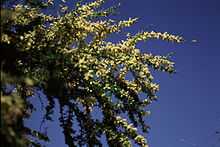Vachellia rigidula
| Vachellia rigidula | |
|---|---|
 | |
| Conservation status | |
| Scientific classification | |
| Kingdom: | Plantae |
| (unranked): | Angiosperms |
| (unranked): | Eudicots |
| (unranked): | Rosids |
| Order: | Fabales |
| Family: | Fabaceae |
| Genus: | Vachellia |
| Species: | V. rigidula |
| Binomial name | |
| Vachellia rigidula (Benth.) Seigler & Ebinger | |
 | |
| Natural range | |
| Synonyms | |
| |
Vachellia rigidula, commonly known as Blackbrush Acacia or Chaparro Prieto, is a species of shrub or small tree in the legume family, Fabaceae. Its native range stretches from Texas in the United States south to central Mexico.[2] This perennial is not listed as being threatened.[3] It reaches a height of 5–15 feet (1.5–4.6 m).[4] Blackbrush Acacia grows on limestone hillsides and canyons.[5]
Phytochemistry
A phytochemical study of V. rigidula[6] by workers at the Texas A & M University Agricultural Research and Extension Center at Uvalde, TX, reported the presence of over forty alkaloids, including low amounts (up to ~ 15 ppm) of several amphetamines that had previously been found by the same research group in the related species Senegalia berlandieri,[7] but which otherwise are known only as products of laboratory synthesis. Compounds found in the highest concentrations (ranging from a few hundred to a few thousand ppm) were phenethylamine, N-methylphenethylamine, tyramine and N-methyltyramine. Other notable compounds reported were N,N-dimethyltryptamine, mescaline, and nicotine, although these were found in low concentrations (e.g. mescaline at 3-28 ppm).
The presence of such an unprecedented chemical range of psychoactive compounds, including ones not previously found in nature, in a single plant species has led to the suggestion that some of these findings may have resulted from cross-contamination or were possibly artifacts of the analytical technique.[8]
Uses
Blackbrush Acacia is used in weight loss dietary supplements because of its adrenergic amine content. These compounds are claimed to stimulate beta-receptors to increase lipolysis and metabolic rate and decrease appetite.[9]
Gallery
-

Seeds
-

Foliage
-

Bark
References
- ↑ "Acacia rigidula - Benth. Blackbrush Acacia". NatureServe Explorer. NatureServe. Retrieved 2010-10-17.
- ↑ 2.0 2.1 "Taxon: Acacia rigidula Benth.". Germplasm Resources Information Network. United States Department of Agriculture. 1999-09-09. Retrieved 2010-10-17.
- ↑ ILDIS LegumeWeb
- ↑ "Acacia rigidula Benth.". Native Plant Database. Lady Bird Johnson Wildflower Center. Retrieved 2009-06-30.
- ↑ "Blackbrush Acacia, Chaparro Prieto, Catclaw, Gavia". Texas Native Plants Database. Texas A&M University. Retrieved 2009-06-30.
- ↑ B. A. Clement, C. M. Goff, and T.D. A. Forbes (1998). "Toxic amines and alkaloids from Acacia rigidula." Phytochem. 49 1377-1380.
- ↑ B.A. Clement, C. M. Goff and T. D. A. Forbes (1997). "Toxic amines and alkaloids from Acacia berlandieri." Phytochem. 46 249-254.
- ↑ "Acacias and Natural Amphetamine". Ask Dr. Shulgin Online. Center for Cognitive Liberty & Ethics. 2001-09-26.
- ↑ WO application 2006099274, Jared R. Wheat, "Dietary Supplement and Method of Using Same", published 2006-09-14
External links
![]() Media related to Vachellia rigidula at Wikimedia Commons
Media related to Vachellia rigidula at Wikimedia Commons
![]() Data related to Vachellia rigidula at Wikispecies
Data related to Vachellia rigidula at Wikispecies
